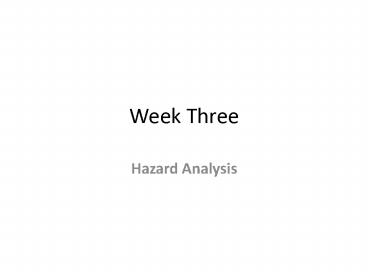Week Three PowerPoint PPT Presentation
Title: Week Three
1
Week Three
- Hazard Analysis
2
Hazard Analysis
- All potential hazards that may occur at each step
outlined in the flow chart must be identified. - When deciding what hazards may occur,
consideration should be given to - the process that is occurring
- the particular properties of the product
- any other raw materials added
- equipment in contact with the food
- amount of contact by food handlers and
- packaging or storage containers.
- When identifying the hazards, only consider what
is happening at - that step. If other food substances are added,
hazards related - with these ingredients would also need to be
identified
3
Use Table 2.5 in Template
4
What is a hazard?
- A hazard is a biological, chemical or physical
agent, or condition of food with the potential to
cause an adverse health affect. - Typical hazards include
- Growth of food poisoning microorganisms
(pathogens) - Microbial or physical contamination from food
handlers - Microbial or physical contamination from
equipment - Survival of food poisoning microorganisms
- Use decision tree to identify CCPs
- Revise Physical, Chemical and Biological hazards
5
The CCP Decision Tree
- The decision tree is a series of questions that
should be asked for each hazard at each step to
determine if a CCP is required at that step. - It would be expected that different types of
businesses will have different CCPs, although
generally speaking CCPs would include cooking,
storage and transportation steps for ready-to-eat
products. - Sometimes, the CCP Decision Tree will identify a
hazard as a CCP, but if an effective support
program has been put in place (eg Cleaning and
Sanitation Program) then the CCP can be
classified as a support program instead.
6
Risk Analysis
Accept
Reject
7
Acceptable Risk
- If a risk cannot be controlled other than trying
to purchase safe raw material you need to assess
the risk - To assess the risk there are three factors to
consider - How often is the food consumed
- What is likelihood that an illness will develop
- Chance that food in contaminated
- Pathogenistity of disease causing agent
- What is the consequence of illness
- How severe are the symptoms
- See Risk analysis matrix
8
(No Transcript)
9
(No Transcript)
10
Physical (Hard Foreign Object) Hazards
- Liability
- Hard foreign objects in food cost the retail food
industry 5 times more in liability than all
microbiological and chemical causes. The reason
is obvious. When customers discover a foreign
material in food, they have the food in their
possession and there is no denial of the source.
11
Physical hazards from the Person
12
Physical hazards from the Person
- Hot food and beverages
- The quality temperatures for serving hot food
such as soups and hot beverages when the customer
eats it is 170F or hotter, and for casseroles
and vegetables is 150F. - When serving soup and hot beverages, servers must
be careful not to spill hot liquid on the bare
skin of a customer. - When pouring hot coffee and refilling coffee
cups, great care must be taken to not let the not
coffee spill on the customer.
13
Physical hazards from the Person
- Hair
- A person may lose 100 hairs each day. Clean hair
is not a microbiological hazard since it contains
so few pathogens. - Jewelry
- In order to keep hard foreign objects out of
food, service personnel should wear a minimum of
jewelry. - Food production employees should wear no
jewelry. Jewelry settings can loosen and fall
into food, causing hazards to customers. - Fingernail Polish
- Fingernail polish chips are not hazardous to
customer's health. However, customers dislike
finding this type of material in their food. - Small Items
- Employees must be careful not to allow small
items such as coins, buttons, and name tags to
fall into food. - Long neckties and scarves should be tied or
restrained to prevent them from falling into food
or catching in equipment - Band-aid Poor employee practices
- Pen caps Poor employee practices
14
Physical hazards from Premises
- Type Origin
- Metal Poor maintenance
- Bolts, nuts, screws,
- screens/sieves, steel Wool
- Glass Poor maintenance
- Light bulbs, watch crystals,
- thermometers, etc.
- Wood splinters Pallets, equipment
bracing, overhead structure - Paint ?akes Equipment, overhead structure
15
Physical hazards from Pests
- Type Origin
- Insects Environment, electrocution
traps, incoming ingredients - Rodents/poo Inadequate rodent controls,
incoming ingredients
16
Physical hazards from the Plant
- Type Origin
- Gasket material Inadequate preventive
maintenance of equipment - Grease Poor equipment
maintenance programme - Broken Knife blade Employees
- Bolts, nuts, screws, Poor equipment
- screens/sieves maintenance
- Mould Poor sanitation,
inadequate cleaning of equipment
17
Physical hazards from Packaging
- Type Origin
- Ties
- Wrappings
- Lids
- Glue lumps
- Carton pieces
18
Physical hazards from Product
- Type Origin
- Carcass ID tags Slaughterhouse
- Hypodermic needles Veterinarian
- Bullets/shot kangaroo Animals shot while
in ?elds - Feathers Poor sanitation,
inadequate pest (bird) controls - Hair Meat ingredients,
employees, clothing, rodents - Dirt, rocks Raw materials, poor
employee practices

